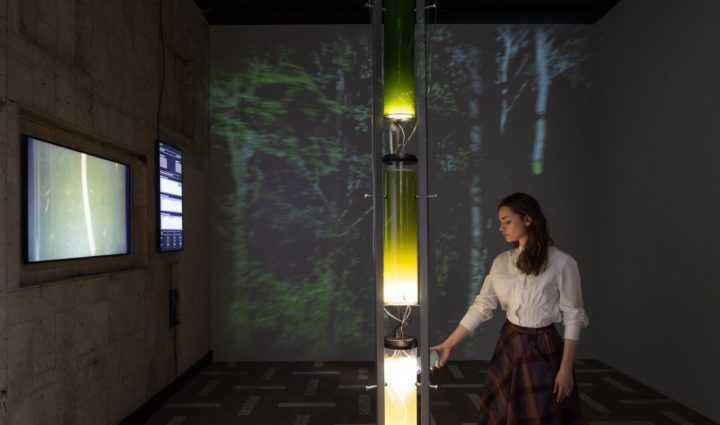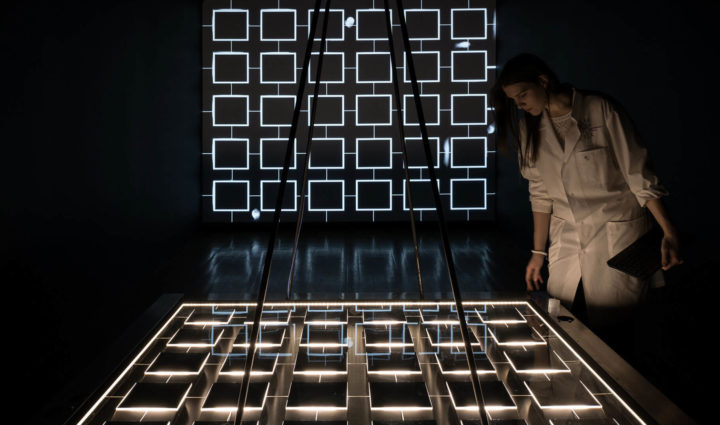The INFUSION project presents the results of interaction between artists based in Moscow and members of the Neuroscience Department at The Kurchatov Institute National Research Center. Their meetings were held in the laboratories of the Neuroscience Department and in the LABORATORIA Art&Science Space.
The main subject of their communication was contemporary brain research: an understanding of higher nervous activity, behavior, mental processes and memory. These questions are central for both scientists and artists. The essential condition for the works to be included into the project was their relevance to the criteria of “adequate dialogue” between arts and science:
- understanding of the relevant scientific agenda
- openness to the interaction with scientists
- visual expressiveness
On 14th of June 2011 the participants of the project along with invited experts took part in an interdisciplinary discussion. During the discussion scientists gave their comments on the ideas presented by the artists. After the discussion and in the process of implementation many projects underwent considerable changes. Some works were made solely by artists, and some – by creative collaborations of scientists and artists. Documentation of the discussion became a foundation for the key project of the exhibition – multichannel video installation, consisting of seven screens, where one can see the main episodes of the meeting between artists and scientists.
Artworks
All the artworks exhibited within the INFUSION project were created for the LABORATORIA Art&Science.
The analysis of the experiment’s outcome allowed us to divide the art projects into three sections.
Section I consists of the works made by artists Ira Korina, Valia Fetisov and Rosan Tavasiev, who applied approved schemes of scientific experiment and thus created special and relevant environments, which let them widen the existing scientific research.

On the nature of creativity
Autors: artist Rostan Tavasiev, mathematician Konstantin Lakhman, psychologist Olga Gerasimova, mathematician Mikhail Burtsev
Performance, multimedia installation, 2011
Photo: Alan Vouba
On the nature of creativity
Autors: artist Rostan Tavasiev, mathematician Konstantin Lakhman, psychologist Olga Gerasimova, mathematician Mikhail Burtsev
Performance, multimedia installation, 2011
Photo: Alan Vouba
Installation of experience
Authors: artist Valia Fetisov, neurophysiologist Olga Svarnik
Interactive istallation, room, 2011
Photo: Alan Vouba
Installation of experience
Authors: artist Valia Fetisov, neurophysiologist Olga Svarnik
Interactive istallation, room, 2011
Photo: Alan Vouba
Neuron draws neuron
Authors: artist Ira Korina, neurophysiologist Alexander Kaplan
Twochannel videoinstallation, 9’02”, drawing, 2011
Photo: Alan Vouba
Neuron draws neuron
Authors: artist Ira Korina, neurophysiologist Alexander Kaplan
Twochannel videoinstallation, 9’02”, drawing, 2011
Photo: Alan Vouba
Section II consists of ‘adventurous suggestions’ of the artists Sergey Shutov, Natalia Zintsova and Maxim Ksuta. These suggestions don’t have an approved scientific relevance (first of all because of the all-embracing and paradoxical approach to the topic).

The Ministry of the truth of the peace dove
Authors: artist Sergey Shutov, scientific consulting by Konstantin Anokhin, neurobiologist
Pigeon loft, videoinstallation, drawings, text, 2011
Photo: Alan Vouba
The Ministry of the truth of the peace dove
Authors: artist Sergey Shutov, scientific consulting by Konstantin Anokhin, neurobiologist
Pigeon loft, videoinstallation, drawings, text, 2011
Photo: Alan Vouba
The Ministry of the truth of the peace dove
Authors: artist Sergey Shutov, scientific consulting by Konstantin Anokhin, neurobiologist
Pigeon loft, videoinstallation, drawings, text, 2011
Photo: Alan Vouba
Supporting materials
Authors: artist Natalia Zintsova, Olga Svarnik, neurophysiologist, Olga Efimova, neurobilogist
Video. 1:18 and 37:00, 2011
Photo: Alan Vouba
Supporting materials
Authors: artist Natalia Zintsova, Olga Svarnik, neurophysiologist, Olga Efimova, neurobilogist
Video. 1:18 and 37:00, 2011
Photo: Alan Vouba
Thought script
Maxim Ksuta
Sketch of futurological machine, print on paper, 2011
Photo: Alan Vouba
Section III presents the projects of Andrey Kuzkin, Dmitry Teselkin, Yury Albert and Arkady Nasonov that criticize the mere possibility of interaction between artistic and scientific mentality, ascertain the invincibility of the medium barrier and the rupture between mainstream, scientific and cultural values.

Empty brain
Andrey Kuzkin and Dmitry Teselkin
Performance, installation, objects, 2011
Answers about art
Authors: artist Yury Albert
participants: mathematician Mikhail Burtsev, neurobiologist Olga Efimova, neurophysiologist Olga Svarnik
LED displays, 2011
Photo: Alan Vouba
Brain work qualification table
Arkady Nasonov
2011
Photo: Alan Vouba
In the context of this project, the artists’ research into the brain is not just another quick intrusion into the field of science, but an experiment where the primary goal is compromise and the need to listen to other people is transformed into a new kind of quality and becomes the actuality of artistic self-expression synchronized with contemporary science.
Mikhail Burtsev, scientific advisor:
“The Kurchatov Center for Converging Technologies (NBIC) was created to develop emerging technologies on the boundaries of nano-, bio-, information and cognitive sciences. The Center’s neuroscience department is taking part in the INFUSION art&science project. The research work of the department is focused on algorithms of information processing, learning and behavioral control in both natural and hybrid neuronal systems with the aim to create new bionic technologies.
Research at the department is carried out on the cutting edge of science. The scientists of the department created one of the first facilities in the world that scans the whole brain of a mouse with cellular resolution. This technology, called ‘Transparent brain’, allows the rodent’s brain to be made transparent. Then, by scanning it with a flat laser, the activation of fluorescent markers through the entire brain can be registered. And thus the technology lets us ‘stop thoughts’ and see exactly which nervous cells in the animal’s brain are involved in the process of learning. ‘Transparent brain’ makes an important contribution to the emerging field of neuroscience – connectomics – which is focused on providing a highly detailed reconstruction of the structure and molecular processes taking place in the brain as a whole.
Contemporary scientific practice is becoming more and more open to new forms of creative interaction where scientists and artists meet. Participation in such projects helps scientists to recognize the social effects of their research and innovations. Artistic rethinking of scientific results gives a scientist a new viewpoint and a new scale to observe his field of action – ‘to see the forest through the trees’. This change of perspective is a stimulus to give scientific thought new directions and a chance to discover new phenomena”.

















